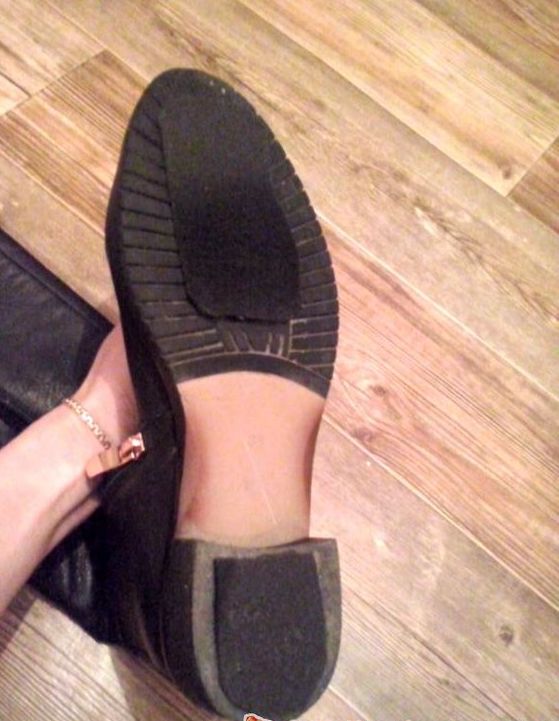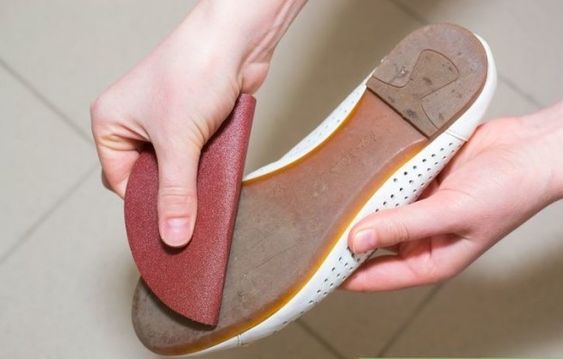Have you ever bought the best shoes of your choice that make many people to turn around and look at you because you are wearing one of the most expensive and perhaps best brands of shoes?  What many of those who glare at you may not beware of is the nice-looking shoes are very slippery no matter the surface. That brings us to the biggest question of the moment – what can you put on the bottom of shoes to make them less slippery?
What many of those who glare at you may not beware of is the nice-looking shoes are very slippery no matter the surface. That brings us to the biggest question of the moment – what can you put on the bottom of shoes to make them less slippery?
The good news is that there are many options to answering the question how to make shoes non-slip. In this 3-minute read blog, I’m going to share with you 7 slippery shoe hacks that will help you change the way your shoes behave on various surfaces.
Also learn How to Keep Your Feet Dry in Work Boots
How To Make Shoes Less Slippery
As mentioned at the beginning, some shoes look exceedingly good. However, they can pose a challenge when walking on various surfaces especially if the surfaces have some wetness. Look at these 7 hacks on how to fix slippery shoes at home and at work:
1. Scuff The Soles Using Sandpaper
Scuffing your shoes’ soles is one of the best and easiest ways to make your shoes less slippery. In order to scuff the soles, you will need to scrub the bottom of your shoes using sandpaper. Although there is no rule on the type of sandpaper you will use, chances are you need to use the right size of grain.
On one hand, using sandpaper with large grains will wear out your sole faster than you thought especially if you are forced to sand the sole regularly. On the other hand, using sandpaper with fine grains will not create any change thus you will not achieve your goal of how to make your shoes slip resistant.
2. Use The Ground To Scuff Your Shoe Soles
We are not done with scuffing. Because scuffing is a simple but effective method, there is no doubt that many people prefer it to many other ways of making shoes less slippery. Remember that no matter how slippery-proof the shoes they may be, they will always be slippery when they are new.
Related: Best non slip work boots
Of course, after some time, the degree of slipperiness declines as you continue to use the shoes on various rough surfaces. In this method, you will need to wear your shoes as you normally do but occasionally, when you have the time, scuff them on the ground.
As you continue to scuff the shoes, you will realize that the sole will begin to chip off. That way, you would be giving your new shoes a measure of slip-resistance.
Also Read:
3. Use Puffy Paint
You can enhance your shoes slip resistance by applying puffy paint on the bottom of the shoes. It is a good thing to remember that shoes with the highest level of slip resistance have always depended on puffing technique.
Many high-end artistry use puffing technique. Thanks to its ability to help bring two or more things together, many shoe and cloth manufacturers use the technique. Because of the technique’s high-level adhesiveness, many manufacturers use it on winter boots to make the boots as slip-proof as possible.
For you to do it like a pro, apply the puffy paint on the sole and allow it enough time to dry. By according the sole ample time to dry, you would be enhancing the strength of the slip-resistance on that important part of your boots.
The right place to let your shoes dry up from is under a shade. Placing your shoes on the sun would otherwise melt up the puff paint.
You will need to apply the paint as often as it may be necessary if you want to increase the shoe’s slip-resistance.
Also Read:Tips on how to make how to make steel toe boots more comfortable
4. Use Spray Pads
Spray pads are also referred to as spray on coats. Spray pads work well if they are sprayed evenly on the sole of the shoes. For this technique to work for you, it is advisable to apply a thin layer of the spray at the bottom of your shoes. You should not leave out a part that is not covered with the spray for the part will be the weak point.
5. Invest In An Ankle Strap
Ankle strapping is another ingenious way of increasing shoes resistance against slippery surfaces. If you find the best ankle strap, you will forget the issue of falling down at least for a couple of months even if you wore your shoes on a daily basis.
A good ankle strap is fitted with switch cable attachments that enable you to fix the strap with ease of each shoe. Some of the premium ankle straps in the market come with lifetime a warranty, which means you will enjoy premium non-slip services as long as the strap is valid.
Thanks to a good ankle strap, you will not have a problem walking on greasy floors such as those found in garages, wet restaurants or busy workshops.
6. Increase Sole Traction With A Masking Tape
Masking tapes work perfect on increasing shoes slip-resistance only if you know how to apply them. The best application technique is by drawing an X-shape on the sole of the shoe, apply the tape and you are ready to step on the ground.
Although the tape is likely to leave behind marks on some floors, a masking tape is among the effective ways of making shoes slip resistant. If you are struggling with slippery shoes inside the house, you’d better think about this method especially if the floor is made of terrazzo or wood.
The only setback with using masking tapes is that you will need to apply it on your shoe’s soles after walking a few kilometers. However, you don’t need to apply it regularly if you are indoors.
7. Try Using a Nail File
Yes, a nail file may be a good tool to sharpen, shape, and trim you nails but it is also a good tool in making shoes slip proof. To be able to use this tool effectively, you will need to turn up your shoes, access the sole, especially the part of the sole that gets in constant contact with the ground. Upon accessing the part of the sole, scuff it until you make sure, you remove a section of the outsole.
The shoe’s ankle and the area around the bottom side of the toe are the sensitive parts you need to scuff using the nail file. If you want to try this technique, I’d recommend you use a metal nail file as opposed to plastic nail files.
Some people say you can you use hot glue to make shoes slip resistant but you need to be careful not to overheat the glue.
Final Thoughts
To that end, if someone asked you the question, what can you put on the bottom of shoes to make them less slippery. You would have given the person seven irresistible hacks that can increase slip-resistance even on shoes that are otherwise originally slippery on any ground. Once you find a technique that works for you, stick to it.
